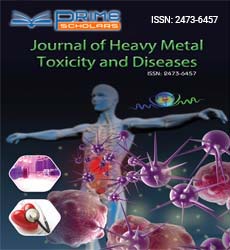Perspective - (2023) Volume 8, Issue 6
The Silent Journey: Understanding the Transfer of Heavy Metals Through the Food Chain
Jooh Lee*
Department of Life Science, Okayama University, Japan
*Correspondence:
Jooh Lee,
Department of Life Science, Okayama University,
Japan,
Email:
Received: 29-Nov-2023, Manuscript No. ipjhmct-24-18977;
Editor assigned: 01-Dec-2023, Pre QC No. ipjhmct-24-18977 (PQ);
Reviewed: 15-Dec-2023, QC No. ipjhmct-24-18977;
Revised: 20-Dec-2023, Manuscript No. ipjhmct-24-18977 (R);
Published:
27-Dec-2023, DOI: 10.21767/2473-6457.23.6.56
Introduction
Heavy metals, ubiquitous in the environment due to industrial
activities, pollution, and natural processes, pose a significant
threat to human health. One of the primary pathways through
which these toxic substances reach humans is the food chain.
This article delves into the intricate process of the transfer of
heavy metals through the food chain, exploring the sources,
mechanisms, and implications for both the environment and human
well-being.
Description
Heavy metals enter the environment through various sources,
including industrial discharges, agricultural runoff, atmospheric
deposition, and natural weathering of rocks. Common heavy
metals of concern include lead, mercury, cadmium, arsenic, and
chromium. Once released into the environment, these metals
can persist for extended periods and accumulate in soil, water,
and air. The journey of heavy metals through the food chain often
begins with the uptake of these substances by plants. Through a
process known as bioaccumulation, plants absorb heavy metals
from the soil or water in which they grow. The roots of plants
play a crucial role in this uptake, allowing metals to move from
the surrounding environment into the plant tissues. Soil acts
as a reservoir for heavy metals, providing a medium through
which these substances can be transferred to plants. Additionally,
heavy metals in aquatic ecosystems often bind to sediments,
where they can be taken up by aquatic plants. Soil and sediment
quality, therefore, significantly influence the bioavailability and
transfer of heavy metals to the biota. In aquatic ecosystems,
heavy metals can be transferred to various organisms, starting
with phytoplankton and algae. These microorganisms form the
base of the aquatic food chain, and their uptake of heavy metals
sets the stage for the bioaccumulation process. Zooplankton
and filter-feeding organisms, such as mussels and clams, further
concentrate heavy metals from the water. Invertebrates, such
as insects and crustaceans, play a crucial role in the transfer of
heavy metals through the food chain. These organisms can accumulate
metals from plants or directly from the environment. In
aquatic ecosystems, benthic invertebrates, like aquatic insects,
can concentrate heavy metals from sediments. Fish, being a key
component of many diets globally, become major vectors for the
transfer of heavy metals to humans. Predatory fish that feed on
smaller fish or invertebrates in contaminated waters can accumulate
high levels of heavy metals. Additionally, seafood, including
shellfish and mollusks, can also be sources of heavy metal
exposure for humans. The process of bioamplification occurs
as heavy metals move up the food chain. Predatory species at
higher trophic levels accumulate higher concentrations of heavy
metals compared to their prey. This phenomenon is particularly
pronounced in aquatic ecosystems, where larger fish, such as
sharks or tuna, may contain significantly elevated levels of heavy
metals. In terrestrial ecosystems, the transfer of heavy metals
through the food chain occurs similarly. Plants take up metals
from the soil, which are then consumed by herbivores. Predators
at higher trophic levels may accumulate heavy metals from their
prey. While the dynamics differ from aquatic ecosystems, the
potential for bioaccumulation and transfer to humans remains.
The ultimate concern in the transfer of heavy metals through the
food chain is human exposure. Consumption of contaminated
food, particularly fish, shellfish, and certain crops, can lead to
chronic exposure to heavy metals.
Conclusion
The transfer of heavy metals through the food chain is a complex
and intricate process with profound implications for both ecosystems
and human health. Understanding the sources, mechanisms,
and consequences of this transfer is crucial for developing
effective mitigation strategies and regulatory measures. As we
strive to address the global challenge of heavy metal contamination,
a multidisciplinary approach involving scientists, policymakers,
and the public is essential to ensure the safety of our food
supply and the protection of human well-being.
Citation: Lee J (2023) The Silent Journey: Understanding the Transfer of Heavy Metals through the Food Chain. J Heavy Met Toxicity Dis. 08:56.
Copyright: © 2023 Lee J. This is an open-access article distributed under the terms of the Creative Commons Attribution License, which permits unrestricted use, distribution, and reproduction in any medium, provided the original author and source are credited.

